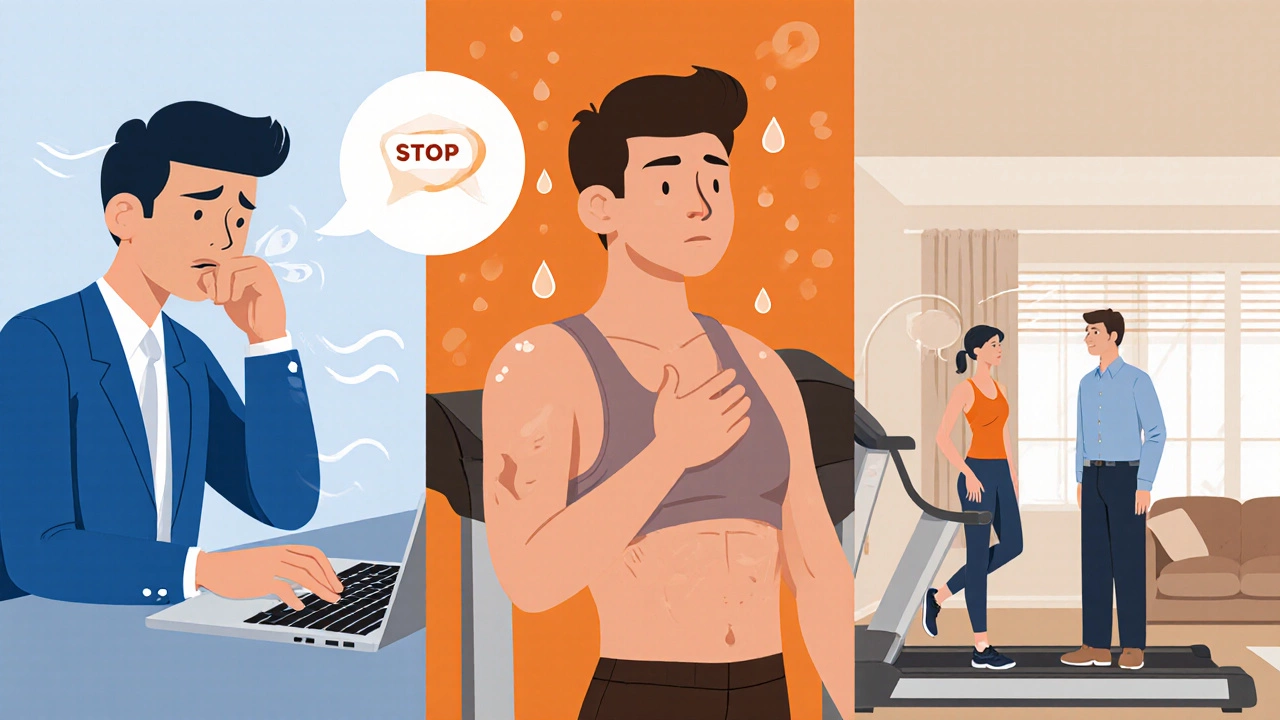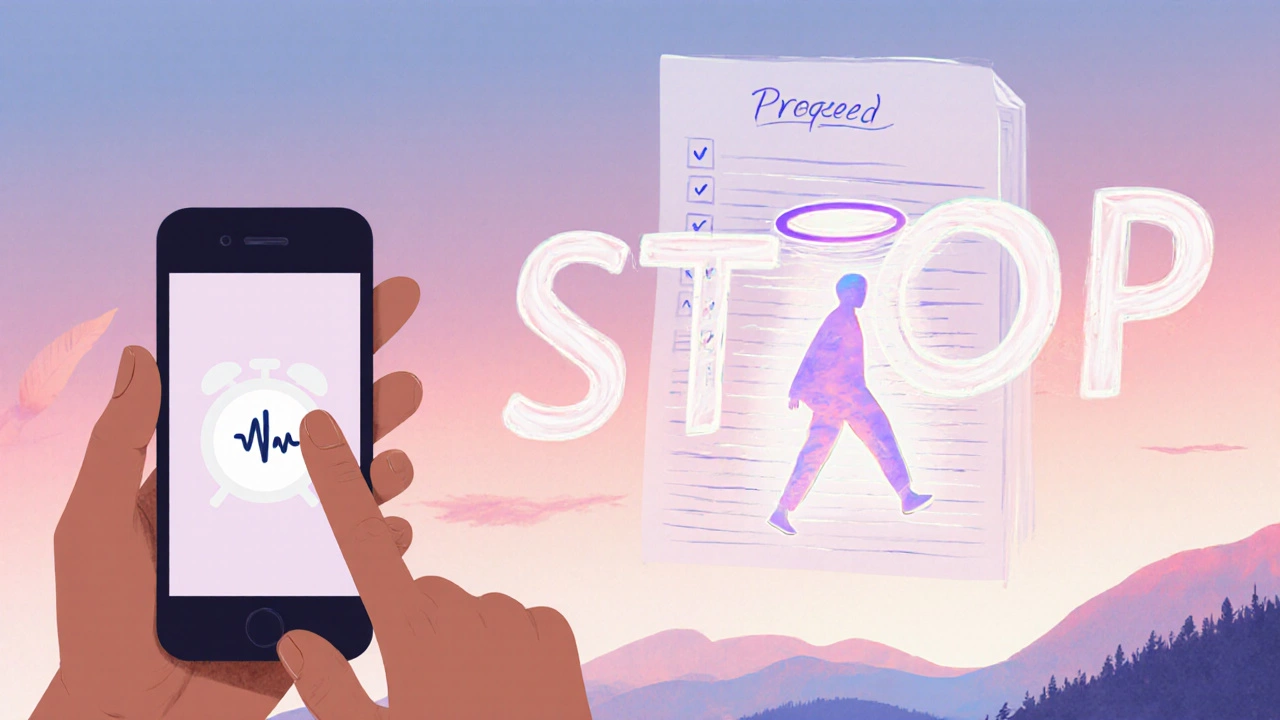STOP Mindfulness Acronym Guide
Pause your current activity and interrupt automatic reactions.
Draw a slow, deep breath to activate your parasympathetic nervous system.
Notice your physical sensations, emotions, and thoughts without judgment.
Choose a thoughtful, intentional response based on your observations.
Try this simple STOP exercise:
- Stop what you're doing right now
- Take a deep breath in for 4 seconds
- Hold for 2 seconds
- Exhale slowly for 6 seconds
- Observe how your body feels
- Decide what to do next
Here are some situations where STOP can help:
- Workplace conflict: Before reacting to criticism, pause and breathe
- Driving stress: Use STOP to manage road rage or traffic frustration
- Family tension: Take a moment before responding to family members
- Public speaking: Use STOP to calm nerves before presenting
How to Apply STOP:
Ever heard someone mention the STOP mindfulness technique and wondered what the letters actually stand for? It’s a quick, five‑step pause that helps you break out of autopilot, calm the nervous system, and respond rather than react. Below you’ll get the full breakdown, step‑by‑step guidance on how to use it in everyday moments, and tips to avoid common slip‑ups.
What is STOP Mindfulness?
STOP mindfulness is a brief, structured mindfulness pause that workers, therapists, and teachers use to manage stress and improve focus. The acronym stands for Stop, Take a breath, Observe, Proceed. Each component builds on the previous one, creating a mental reset that can be applied anytime, anywhere.
Decoding the Acronym
Let’s unpack each letter and see how the practice works in real life.
- Stop - Literally hit the mental “pause” button. This interrupts whatever you’re doing, halting the cascade of thoughts that may be steering you toward a knee‑jerk reaction.
- Take a breath - Draw a slow, deep inhale through the nose, then exhale gently. Breathing activates the parasympathetic nervous system, lowering heart rate and cortisol.
- Observe - Survey your internal and external experience. Notice sensations, emotions, and thoughts without judging them.
- Proceed - Choose a conscious response based on what you observed, rather than an automatic habit.
In practice, you might go through STOP in under a minute, yet the impact can linger for minutes or even hours.
How to Use STOP in Different Settings
Below are three common scenarios where STOP shines.
- At work: A tense email triggers anger. Before firing off a reply, pause, breathe, observe the surge of irritation, then draft a calm response.
- During a workout: If fatigue spikes, STOP, take a breath, feel the muscle tension, and decide whether to push through or rest.
- In relationships: When a partner says something that feels hurtful, STOP, breathe, notice the sting, and choose to discuss rather than shut down.

Why STOP Works: The Science Behind the Steps
Mindfulness research shows that short pauses trigger neuroplastic changes in the prefrontal cortex, the brain’s decision‑making hub. By stopping and breathing, you lower the amygdala’s threat response, giving the cortex a chance to observe without emotional hijack.1 The observation phase engages “meta‑awareness,” a skill linked to reduced rumination and better emotional regulation.2
Comparing STOP with Other Quick‑Mindfulness Tools
| Feature | STOP | RAIN |
|---|---|---|
| Primary Goal | Immediate reset for reactive moments | Deep processing of difficult emotions |
| Steps | Stop, Take a breath, Observe, Proceed | Recognize, Allow, Investigate, Nurture |
| Typical Duration | 30‑60 seconds | 2‑5 minutes |
| Best For | High‑stress, fast‑paced environments | Therapeutic settings, deep self‑inquiry |
| Learning Curve | Very low | Moderate |
Both methods are evidence‑based, but STOP’s brevity makes it ideal for on‑the‑fly moments, while RAIN is useful when you have the space to sit with a tough feeling.
Common Pitfalls & How to Avoid Them
Even simple tools can go sideways if you’re not mindful of the process.
- Rushing the breath: Shallow, rapid breathing can increase anxiety. Aim for a 4‑second inhale, 6‑second exhale.
- Skipping observation: Jumping straight to “Proceed” defeats the purpose. Take a moment to label what you’re feeling (“I notice tension in my shoulders”).
- Using STOP as avoidance: If you use the pause to escape a problem rather than face it, you may delay necessary action. Observe the issue, then decide how to address it.
- Inconsistent practice: Like any skill, STOP gets stronger with regular use. Set a reminder to practice a few times daily.

Quick Checklist: Your STOP Routine at a Glance
- 🔹 STOP - Mentally say “stop” out loud or in your head.
- 🔹 Take a breath - Inhale 4 counts, exhale 6 counts.
- 🔹 Observe - Scan body, notice emotions, name thoughts.
- 🔹 Proceed - Choose a response aligned with your values.
Mini‑FAQ: Answers to Your Most Likely Follow‑Up Questions
What does the "O" in STOP stand for?
Observe
Observe means to notice whatever is happening inside and around you-physical sensations, emotions, thoughts-without labeling them as good or bad.
Can I use STOP while driving?
Is it safe?
Yes, as long as you keep your eyes on the road. A quick mental "stop," a breath, and a brief body scan can calm road‑rage without taking your focus off driving.
How often should I practice STOP?
Frequency
Aim for three intentional pulls per day-morning, midday, and evening. You’ll also naturally use it whenever you sense a surge of stress.
Is STOP a replacement for longer meditation?
Complement, not replace
STOP works best as a quick‑access tool. Longer practices like seated meditation deepen the same skills but require dedicated time.
What if I can’t calm down after STOP?
When STOP isn’t enough
If anxiety spikes, try a second round or combine STOP with grounding techniques like "5‑4‑3‑2‑1" (identify five things you see, four you feel, etc.). If patterns persist, consider professional guidance.
Next Steps: Building a Personal STOP Habit
1️⃣ Set a cue: Choose a trigger-phone alarm, a specific location, or the start of a meeting-to remind you to pause.
2️⃣ Practice in low‑stakes moments: Try STOP while waiting in line or brushing your teeth. This builds muscle memory.
3️⃣ Track progress: Jot down brief notes after each use. Over a week you’ll see patterns in what you observe and how your responses improve.
4️⃣ Scale up: Once comfortable, integrate STOP into crisis moments-public speaking anxiety, conflict with a colleague, or sudden overwhelm.
5️⃣ Combine with deeper practice: Pair STOP with a 10‑minute daily meditation to reinforce the same attentional networks.
By treating STOP as a simple, repeatable habit, you turn a fleeting pause into a powerful lever for calmer, more intentional living.





